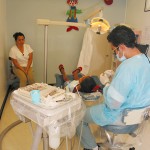Pediatric dentistry is a specialized field of dentistry that is focused on treatment and oral health care for children. A normal dentist is fully trained and capable of treating a child, however, in special cases like children with special diseases or disorders, they might need help from a pedodontist i.e. a dentist who specializes in pediatric dentistry. Furthermore, if it is necessary to carry out complex procedures such as sedation and general anesthesia while treating a child, it is best to be done by a pedodontist instead of a general practitioner, as the pedodontist will have more detail knowledge and experience.
Why is dental treatment different for children and adults?
Treatment planning for a child is far different for treatment planning for an adult in every treatment session. This is because a child is young, which gives them less control over their emotions such as fear and anxiety. They tend to cry, shout, and kick when they come to a dental visit, and the dentist’s job is to calm the child down and to get the child to trust the dentist. Children are also unable to obey commands well, such as opening their mouth for a long time or brushing with a correct technique, especially when the command comes from a dentist.
Other than that, a child will have primary and mixed dentition compared to an adult who will have permanent dentition. Primary dentitions have thinner enamel and dentine, which makes them more susceptible to dental caries. There are two types of dental caries that are specially seen in young children – bottle mouth caries and rampant caries, which are collectively known as early childhood caries (ECC). When this occurs, long term and intensive treatment need to be done to restore the dentition health.
What are the emotions usually shown by a child?
The emotions that are often displayed by a child when attending a dental appointment are:
1. Fear
2. Phobia
3. Anxiety
4. Crying
5. Anger
Fear is a reaction to a known danger, and there are three types of fear that can be displayed by a child – innate fear, objective fear, ad subjective fear. Innate fear is an inborn reaction, which means that the child had no previous bad experiences with any dentist or dental treatment, but is still afraid of going to the dentist. Subjective fear is almost similar to innate fear, in the sense that the child had never undergone a bad experience before. It is the feeling of fear towards the dentist or the dental treatment due to suggestions by others, such as peers, parents, siblings, or media. Objective fear, on the other hand, is fear that results from a direct stimulation of the sensory organs, such as the smell of medications and hospitals, or the sight of white lab coats. It also arises due to a previous bad experience with a dentist or a dental treatment.
Phobia is an irrational, intense fear, which leads to conscious avoidance of a particular situation or an object. Anxiety is almost similar to fear, however it arises later than fear. It is the feeling of fear towards an unknown danger, and the intensity of this feeling depends on the vulnerability of the child. And anger is when the child is overwhelmed by the situation and shows an outburst of emotion.
There are four types of cry:
1. Obstinate cry – when the child is overwhelmed by the situation.
2. Compensatory cry – which is not really a cry. It is a dull and low sound that the child makes to drown out the noise.
3. Frightened cry – when there is a torrent of tears accompanied by convulsive sobs.
4. Hurt cry – the eyes of the child initially brimmed with tears, and when a drop of tear finally rolled down the child’s cheeks, the child makes no attempt to wipe it away.
Why is treatment planning for impaired children different from normal children?
An impairment is considered as a disability when the child is not able to carry out the same activities as the peer group. For these children, swift treatment needs to be carried out because of the life threatening situation the dental disease, or the sequelae of the dental disease poses. Treatment for these children will be even more time consuming than usual, and special facilities will be needed. Treatment plans will also need to be modified to suit the child’s condition. These children will also have different prevalence of dental diseases compared to a healthy child, which will require a more frequent recall visit and special attention from the dentist.
A child is not always necessarily treated by a pedodontist, however, under certain special circumstances, the general practitioner may feel the need to refer the child to them.


